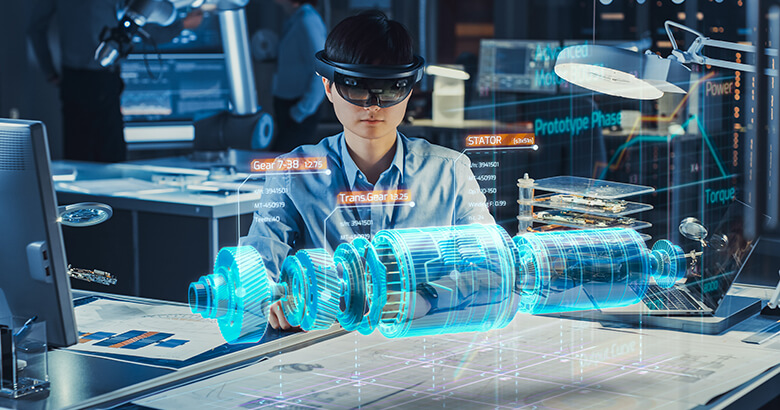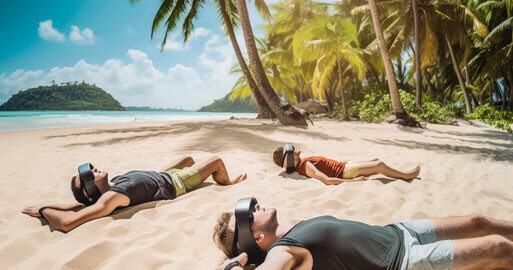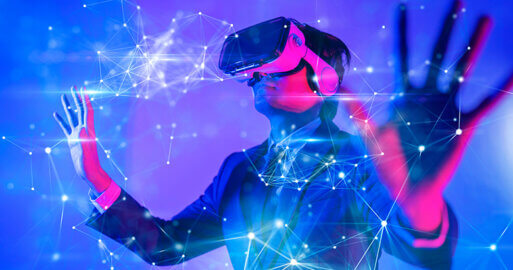Extended Reality (XR) in the World of Work: Is A New Dimension of Productivity and Collaboration on the Verge of a Breakthrough?

In recent years, virtual reality (VR) and augmented reality (AR) have developed into fascinating technologies that are not only causing a stir in the entertainment industry, but they are also increasingly finding their way into the world of work. VR and AR are forms of extended reality (XR) that enable us to experience computer-based and digital simulations immersively and interactively in a real-life context. These graphical data processing technologies are several decades old, but they have the potential to revolutionize the way we work together due to their increasing maturity, increasing availability and the ongoing penetration of digitalization and networking. In this blog, you will learn about the importance of XR in the working worlds of today and tomorrow, as well as the demands that will be placed on data management and integration. Are we on the verge of a breakthrough?
Let’s start with a brief definition of the types of Extended Reality (XR).
Definition of VR
Virtual reality (VR) refers to a computer-generated environment that allows users to immerse themselves in a completely artificial world. Special VR goggles or headsets are used to generate visual and auditory stimuli that give the user the feeling of actually being in a different place.
Definition of AR
Augmented reality (AR), on the other hand, refers to the superimposition of digital information, such as 3D models or texts, on the user’s real environment. AR is often experienced via mobile devices such as smartphones or tablets, which use cameras and sensors to capture the environment and place digital content accordingly.
Definition of MR
Hybrid forms of VR and AR are referred to as mixed reality (MR). Here, the systems of augmented reality interact with the virtualized reality. For example, real objects can be integrated into the simulation to, for example, make it possible for robots to experience movement or generate haptic feedback (force feedback), e.g., for driving simulation with real control elements.
Importance of XR in the working world
The possible applications, especially of VR and AR in the working world, are diverse and have the potential to improve efficiency, safety and creativity in various industries. The prerequisite for this is 5G technology. Compared to 4G, data transmission with 5G means a tenfold increase in speed as well as significant improvements in terms of capacity and reliability.
Overview of the use of XR in the working world
By offering virtual environments and interactive models, applications with VR/AR/MR technology can optimize work processes, make training more realistic and make complex tasks fundamentally accessible. They are already widely used today or are being used as pioneers in the following cases:
- Virtual training, VR learning platforms and virtual training:¹ VR and AR enable employees to experience safe simulations of real working environments and learn new skills in a safe environment. For example, surgeons can practice complex operations in virtual operating rooms. Complete VR- or AR-based training could also be important for the future world of work.
- VR/AR-based prototype development and design processes: In fields such as architecture, engineering and product development, VR and AR can be used to create virtual prototypes and make design decisions. Spatial visualization allows users to explore products in 3D and identify potential problems before physical prototypes are created.
- Digital working, virtual office and virtual meetings: VR and AR allow employees to work together on projects regardless of their geographical location. Digital working is easier with virtual reality: a virtual presence allows team members to communicate in a shared virtual environment, meet in virtual offices, exchange ideas and work together on documents. These technologies enable better spatial perception and interaction than conventional video conferencing solutions.
- AR-based maintenance and repair of machines: AR-based machine maintenance and repair enables technicians to use special AR glasses or mobile devices to superimpose digital information directly into their field of vision. This information can be technical drawings, instructions or real-time data, for example. This direct visual integration of digital content into the real environment makes it much easier to diagnose faults and rectify problems.
- The Industrial Metaverse as a combination of XR and (I)IoT represents a future field of application but promises to be a breakthrough innovation for digital ecosystems. Increasing digitalization, networking capabilities and the autonomy of products and objects also require new UI concepts that integrate people into the Internet of Things and Services based on XR technologies.
Opportunities and risks of XR in the working world
Augmented realities are on the rise and have the potential to fundamentally change the way we work with others, especially with (IIoT) data and machines. From analysis, design and development processes to production and remote services through to education and training, VR, AR and MR offer innovative solutions that can not only make our working world more efficient, safer and more productive, but they will also have an impact on the world we live in.
Opportunities of XR
Experts are already advising companies to examine the potential of these technologies for their products and processes in general and to take them into account as part of their IIoT platform strategy in order to secure future competitive advantages and connectivity. The following potential opportunities can arise from the use of XR technology in the world of work:
| Selection of XR opportunities |
|
Risks of XR
While new technology offers many advantages, it can also pose risks. The following risks should be considered before implementing an XR application:
| Selection of XR risks |
|
Data management and integration requirements
The integration of virtual, augmented and mixed reality (VR/AR/MR), especially as part of new service offerings in the IIoT, is leading to an explosion in the amount of data that needs to be processed in these technologies. 3D models, high-resolution textures, motion sensor data and user interactions are just a few examples of the diverse data sources that are being integrated into XR applications. Not only real data, but also digital twins and their simulation data must be merged. In some applications, several million data points have to be collected and processed in just a few minutes.² The challenge is to manage this increasing amount of data securely and efficiently while ensuring a seamless and immersive experience for users. This requires powerful processors, graphics units and storage resources. However, the complexity and size of the data can often reach the limits of conventional hardware, which can lead to latency and stuttering that impact the user experience.
The use of cloud systems
The development of applications requires the use of cloud VR/AR or powerful GPU computing nodes, where the actual data processing and data rendering takes place. For the 3D visualization itself, there is the option of streaming finished content to the user’s end devices in real time via the internet or running lightweight applications on less powerful devices.
Without the use of cloud systems, XR applications are difficult to implement or offer locally. Through integration with digital twins, such as those offered via IIoT platforms, XR applications can be suitably implemented as part of a service offering. The digital twin thus becomes a key element in data management and in the data integration of XR applications. These also require continuous real-time processing of data to enable delay-free interaction between users and the virtual world.
Data protection requirements
Once XR applications are in use, data protection requirements must be strictly adhered to in order to protect the privacy and sensitive information of those involved. Personal data is processed in the following examples:
- If employee training or education is conducted using XR technologies, personal data of employees may be collected, such as facial or biometric data, to personalize the user experience. In order to comply with legal requirements, companies must ensure that they obtain the explicit consent of employees and only use the data for the specified purpose. In addition, the collected data must be adequately protected and deleted at the end of its useful life.
- Another risk to employee privacy is that VR/AR applications often use extensive tracking functions to analyze user behavior. Such data can reveal sensitive information and should therefore be handled with the utmost care. To minimize privacy risks, companies should rely on transparent data protection guidelines and provide users with clear information about the type of data collected and the purposes for which it will be used. In addition, anonymization techniques and pseudonymization can be used to make it more difficult to identify individuals.
Data transfer
In addition to data security in terms of data protection, an interoperable and secure transfer of data is also of crucial importance. It is also important here that the data transfer is encrypted and protected by modern security protocols to prevent unauthorized access.
Lack of general standards
For animated 3D data in general, but also for complex 3D scenes, there was a lack of established standards that were particularly suitable for VR/AR applications. The new AOUSD³ initiative for the establishment and further development of OpenUSD (Open Universal Scene Description) is viewed with optimism, as this could bring a breakthrough in the use and establishment of XR applications. It will at least play a decisive role for the metaverse.
SEEBURGER Research & Innovation
XR applications offer a wealth of opportunities for the world of work and can establish themselves as a new medium for human-machine interaction and IIoT services. They also provide a promising medium for the increasingly important areas of AI and AI-based systems. XR will raise creativity and productivity in collaboration to a new level and generate a wide range of new application possibilities that will also create new B2B cooperation and exchange processes.
The increasing digitalization of interaction with applications, services and things raises questions about securing governance and data sovereignty to provide a basis for new business relationships in digital ecosystems. SEEBURGER is actively exploring breakthroughs in the technological and application-related requirements for B2B and the business integration of tomorrow through research and innovation. These will set the course and form new building blocks for future product and service development.
Find out how digital twins orchestrate the value stream in the IIoT in our blog by Viktor Schubert.
¹ Einsatz von Virtual Reality im Arbeitsschutz: DGUV forum 3/2022: DGUV forum
² Data Protection & VR/AR/MR: Datenschutz in virtuellen Welten? (aspekteins.com)
Thank you for your message
We appreciate your interest in SEEBURGER
Get in contact with us:
Please enter details about your project in the message section so we can direct your inquiry to the right consultant.
Written by: Alexandra Pörner
Alexandra studied German language and literature in Mannheim and Waterloo (Canada). As part of the editorial team at SEEBURGER she combines her passions for language and travel on extensive workations, which she particularly enjoys capturing on camera. When she's not traveling in other climes, she likes to join meetings with a coconut latte at the coffee bar.





